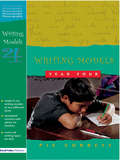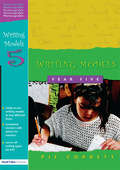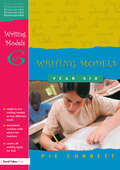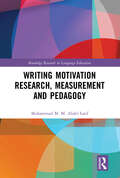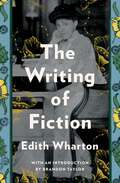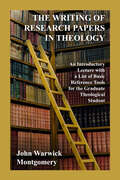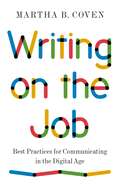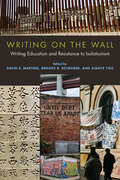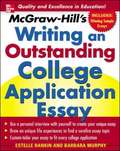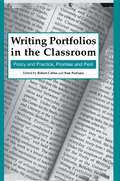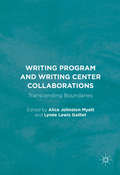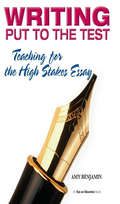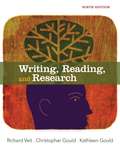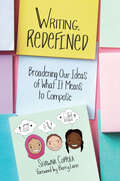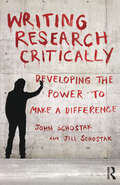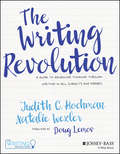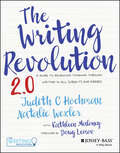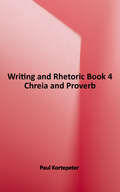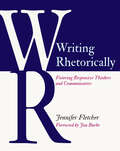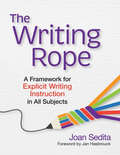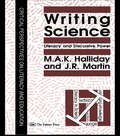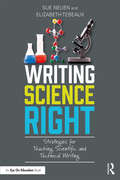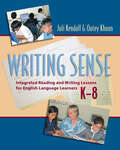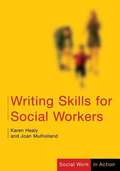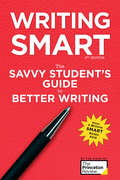- Table View
- List View
Writing Models Year 4 (Writing Models Ser.)
by Pie CorbettTeachers who want to cut lesson planning time should welcome this series. The new editions are revised in line with the new literacy framework and bring you new models. Writing Models aims to help teachers cover every sort of writing type they need; fine tune lessons by following key teaching points for each model; and deliver the new literacy unit
Writing Models Year 5 (Writing Models Ser.)
by Pie CorbettTeachers who want to cut planning time and save energy should welcome this series. It will help teachers to: cover every sort of writing type they need to at Key Stage with a model provided for each one; fine tune lessons by following key teaching points for each model; deliver the literacy hour to pupils of every ability using different versions of the same model.
Writing Models Year 6 (Writing Models Ser.)
by Pie CorbettThe new edition for Year 6 has been fully updated and restructured in line to deliver new units from the new framework and includes new writing models. Lesson planning has never been easier! The revised Writing Models Year 6 contains:A range of fiction genres such as traditional tale, fantasy, chatty style (new), horror (new) and character story an
Writing Motivation Research, Measurement and Pedagogy (Routledge Research in Language Education)
by Muhammad M. Abdel LatifThis book provides a unique reference and comprehensive overview of the issues pertinent to conceptualizing, measuring, researching and nurturing writing motivation. Abdel Latif covers these theoretical, practical and research issues by drawing on the literature related to the eight main constructs of writing motivation: writing apprehension, attitude, anxiety, self-efficacy, self-concept, learning goals, perceived value of writing and motivational regulation. Specifically, the book covers the historical research developments of the field, the measures of the main writing motivation constructs, the correlates and sources of writing motivation, and profiles of motivated and demotivated writers. The book also describes the types of the instructional research of writing motivation, provides pedagogical guidelines and procedures for motivating students to write, and presents suggestions for advancing writing motivation research, measurement and pedagogy. Detailed, up-to-date, and with a glossary which includes definitions of the main terms used in the six chapters, this book will be of great interest to academics, researchers and post-graduate students in the fields of language education, applied linguistics, psycholinguistics and educational psychology.
The Writing of Fiction: The Classic Guide To The Art Of The Short Story And The Novel (The\collected Works Of Edith Wharton)
by Edith WhartonA rare work of nonfiction from Edith Wharton, The Writing of Fiction contains brilliant advice on writing from the first woman ever to win a Pulitzer Prize -- for her first novel The Age of Innocence. In The Writing of Fiction, Wharton provides general comments on the roots of modern fiction, the various approaches to writing a piece of fiction, and the development of form and style. She also devotes entire chapters to the telling of a short story, the construction of a novel, and the importance of character and situation in the novel. Not only a valuable treatise on the art of writing, The Writing of Fiction also allows readers to experience the inimitable but seldom heard voice of one of America's most important and beloved writers, and includes a final chapter on the pros and cons of Marcel Proust.
The Writing Of Research Papers In Theology: An Introductory Lecture with a List of Basic Reference Tools for the Graduate Student
by John Warwick MontgomeryA "how to" on theological research covering little known American and European resourses. Even though this was orignally written in 1957, this is a master class from before the age of the internet and still valuable today.
Writing on the Job: Best Practices for Communicating in the Digital Age
by Martha B. CovenA practical and compact guide to writing for professionalsWriting is an essential skill in today’s workplace. From messaging platforms and social media to traditional forms of communication like memos and reports, we rely on words more than ever. Given how much reading we do on mobile devices, being able to write succinctly is critical to success. Writing on the Job is an incisive guide to clear and effective writing for professionals.Martha Coven begins with the basics, explaining how to develop a professional style, get started on a piece of writing, create a first draft, and edit it into a strong final product. She then offers practical advice on more than a dozen forms of writing, from emails and slide decks to proposals and cover letters. Along the way, Coven provides a wealth of concrete examples and simple templates that make the concepts easy to understand and apply.Based on Coven’s popular writing classes and workshops at Princeton University as well as her decades of experience in the public and private sectors, Writing on the Job addresses the real challenges professionals face in today’s digital age, and shares essential practices that can improve the performance of any organization.
Writing on the Wall: Writing Education and Resistance to Isolationism
by Xiaoye You David S. Martins Brooke R. SchreiberThe first concerted effort of writing studies scholars to interrogate isolationism in the United States, Writing on the Wall reveals how writing teachers—often working directly with students who are immigrants, undocumented, first-generation, international, and students of color—embody ideas that counter isolationism. The collection extends existing scholarship and research about the ways racist and colonial rhetorics impact writing education; the impact of translingual, transnational, and cosmopolitan ideologies on student learning and student writing; and the role international educational partnerships play in pushing back against isolationist ideologies. Established and early-career scholars who work in a broad range of institutional contexts highlight the historical connections among monolingualism, racism, and white nationalism and introduce community- and classroom-based practices that writing teachers use to resist isolationist beliefs and tendencies. “Writing on the wall” serves as a metaphor for the creative, direct action writing education can provide and invokes border spaces as sites of identity expression, belonging, and resistance. The book connects transnational writing education with the fight for racial justice in the US and around the world and will be of significance to secondary and postsecondary writing teachers and graduate students in English, linguistics, composition, and literacy studies. Contributors: Olga Aksakalova, Sara P. Alvarez, Brody Bluemel, Tuli Chatterji, Keith Gilyard, Joleen Hanson, Florianne Jimenez Perzan, Rebecca Lorimer Leonard, Layli Maria Miron, Tony D. Scott, Kate Vieira, Amy J. Wan
Writing An Outstanding College Application Essay
by Estelle Rankin Barbara MurphyFrom the creators of the popular 5 Steps to a 5 program, expert tips on writing college application essays In McGraw-Hill's Writing an Outstanding College Application Essay, two writing coaches show you how to craft an essay that will get you into the top college of your choice. Estelle Rankin and Barbara Murphy's hands-on instruction helps you plan and write well-constructed, engaging college application essays that really hold admissions officers' attention. They nurture an understanding of good writing and teach you to find your voice as a writer. Features include: Using personal interviews to create unique essays Planning and writing the first draft Mining life experiences for topics Tweaking the essay to fit different college applications Samples of winning student essays
Writing Portfolios in the Classroom: Policy and Practice, Promise and Peril
by Robert C. Calfee Pamela PerfumoThis volume presents chapters by researchers, practitioners, and policymakers who study the impact of classroom portfolios in the assessment of writing achievement by elementary and middle grade students. The focus throughout the volume is on the tension between classroom assessment and externally mandated testing. It presents the efforts of researchers, practitioners, and policymakers to understand the impact of classroom portfolios for the assessment of writing achievement by elementary and middle grade students. Under the auspices of the Center for the Study of Writing, the editors conducted a national survey of exemplary portfolio projects, arranged for a series of "video visits," and held several working conferences. The result of this work is a broad-ranging tale: the aspirations of teachers and administrators to move the machinery of schooling in the direction of more authentic and engaging tasks, the puzzlement of students when they realize that the assignments are real and that the teacher may not have a "right answer" in mind, and the tensions between ivory-tower ideas and everyday classroom practice. Divided into four sections, this research volume: * provides a historical perspective, develops the conceptual framework that serves as a background for many activities described throughout, and discusses numerous practical issues that confront today's researchers and practitioners; * views the phenomenon of writing portfolios through a variety of broadview lenses such as teacher enthusiasm, student reflection, assessment tension, the portfolio as metaphor, and the locus of control; * conveys important conceptual issues with a balance toward pragmatics; and * offers unique insights from the perspective of one individual who serves as scholar, researcher, and teacher.
Writing Program and Writing Center Collaborations
by Alice Johnston Myatt Lynée Lewis GailletThis book demonstrates how to develop and engage in successful academic collaborations that are both practical and sustainable across campuses and within local communities. Authored by experienced writing program administrators, this edited collection includes a wide range of information addressing collaborative partnerships and projects, theoretical explorations of collaborative praxis, and strategies for sustaining collaborative initiatives. Contributors offer case studies of writing program collaborations and honestly address both the challenges of academic collaboration and the hallmarks of successful partnerships.
Writing Put to the Test: Teaching for the High Stakes Essay
by Amy BenjaminThis book helps educators improve students’ ability to write clear, coherent essays in response to on-demand writing prompts. While it focuses on students’ abilities to succeed at on-demand writing, it also promotes the teaching of writing as an expression of art and self. For grades 4 -12, it provides examples of responses to narrative and persuasive prompts, and provides savvy advice about what scorers look for.
Writing, Reading, and Research (9th Edition)
by Richard Veit Christopher Gould Kathleen GouldThis text is a composition course that prepares students for the tasks they will face during their college and professional careers developing skills in writing, reading and analyzing information.
Writing, Redefined: Broadening Our Ideas of What It Means to Compose
by Shawna CoppolaWhat does it mean to write or to be a writer? In Shawna Coppola's book Writing, Redefined: Broadening Our Ideas of What It Means to Compose, she challenges the reader to expand beyond standard alphabetic writing and consider alternative forms of composition when assigning writing to students. This book empowers teachers to change what counts as writing in schools and classrooms, opening the door to students who may not consider themselves to be writers, but should and can. Inside you'll find alternative, engaging writing assignments that are visual, aural, or multimodal that will involve all students, specifically those: Who prefer to compose using a wider array of forms and modes For whom standard English is not the norm Who have been identified as dyslexic Whose cultural traditions lean heavily towards more aural forms of composition Who are considered struggling writers By finding ways to accommodate all styles of writers, students are free to unleash their creativity and share their story with others. While there is no question composition in written form is important and worth of study, broadening our definition of writing expands an enormous range of possibilities for composing for all students.
Writing Research Critically: Developing the power to make a difference
by John Schostak Jill SchostakThis is not a standard guide to writing a dissertation, thesis, project report, journal article or book. Rather, this book will help researchers who are dissatisfied with the typical recipe approaches to standardised forms of writing-up and want to explore how academic writing can be used to greater effect. Writing Research Critically shows that writing up is not just about ‘presenting findings’ as if the facts would speak for themselves. As the authors show there are certain vital skills that any writer needs to develop within their academic writing, such as the ability to: develop critical understanding and a personal academic voice question assumptions and the status quo frame the background and transgress the frame read between the lines when reviewing the literature strengthen interpretations and conctruct persuasive arguments challenge and develop theory and explanations develop ideas that create possibilities for realistic action Packed with examples from a range of writing projects (papers, dissertations, theses, reports, journal articles and books), this book provides a practical and refreshing way to approach and present research. Through case studies the authors offer a step-by-step guide from the early stages of planning a writing project, whether an undergraduate paper or a professional publication, to the polishing processes that make the difference between a merely descriptive account to an argument that intends to be critical and persuasive. Written in a clear accessible style this book will inspire a wide range of researchers from undergraduates to postgraduates, early career researchers and experienced professionals working across a wide range of fields, and demonstrate how research can have more impact in the real world.
The Writing Revolution: A Guide to Advancing Thinking Through Writing in All Subjects and Grades
by Natalie Wexler Judith C. Hochman"HELP! My Students Can't Write!" Why You Need a Writing Revolution in Your Classroom and How to Lead It. The Writing Revolution (TWR) provides a clear method of instruction that you can use no matter what subject or grade level you teach. The model, also known as The Hochman Method, has demonstrated, over and over, that it can turn weak writers into strong communicators by focusing on specific techniques that match their needs and by providing them with targeted feedback. Insurmountable as the challenges faced by many students may seem, TWR can make a dramatic difference. And the method does more than improve writing skills. It also helps: Boost reading comprehension Improve organizational and study skills Enhance speaking abilities Develop analytical capabilities TWR is as much a method of teaching content as it is a method of teaching writing. There's no separate writing block and no separate writing curriculum. Instead, teachers of all subjects adapt the TWR strategies and activities to their current curriculum and weave them into their content instruction. But perhaps what's most revolutionary about the TWR method is that it takes the mystery out of learning to write well. It breaks the writing process down into manageable chunks and then has students practice the chunks they need, repeatedly, while also learning content.
The Writing Revolution 2.0: A Guide to Advancing Thinking Through Writing in All Subjects and Grades
by Natalie Wexler Judith C. HochmanLead a writing revolution in your classroom with the proven Hochman Method Building on the success of the original best-seller, this new edition of The Writing Revolution adds valuable guidance for teachers seeking a way to bring their students' writing ability up to rigorous state standards. As thousands of educators have already discovered, The Writing Revolution provides the road map they need, clearly explaining how to incorporate the Hochman Method into their instruction, no matter what subject or grade they're teaching and regardless of the ability level of their students. The new edition provides a reorganized sequence of activities and even more student-facing examples, making it easier than ever to bring the method to your classroom. The Writing Revolution isn't a separate curriculum or program teachers need to juggle. Rather, it is a method providing strategies and activities that teachers can adapt to their preexisting curriculum and weave into their content instruction. By focusing on specific techniques that match their students' needs and providing them with targeted feedback, The Writing Revolution can turn weak writers into strong and confident communicators. In addition, the method can: Identify misconceptions and gaps in knowledge Boost reading comprehension and learning Improve organizational skills Enrich oral language Develop analytical abilities The Writing Revolution takes the mystery out of teaching students to write well.
Writing & Rhetoric Book 4: Chreia & Proverb
by Paul KortepeterThe Writing and Rhetoric series method employs fluent reading, careful listening, models for imitation, and progressive steps. It assumes that students learn best by reading excellent, whole-story examples of literature and by growing their skills through imitation. Each exercise is intended to impart a skill (or tool) that can be employed in all kinds of writing and speaking. The exercises are arranged from simple to more complex. What's more, the exercises are cumulative, meaning that later exercises incorporate the skills acquired in preceding exercises. This series is a step-by-step apprenticeship in the art of writing and rhetoric.
Writing Rhetorically: Fostering Responsive Thinkers and Communicators
by Jennifer FletcherWriting Rhetorically: Fostering Responsive Thinkers and Communicators, author Jennifer Fletcher aims to cultivate independent learners through rhetorical thinking. She provides teachers with strategies and frameworks for writing instruction that can be applied across multiple subjects and lesson plans. Students learn to discover their own questions, design their own inquiry process, develop their own positions and purposes, make their own choices about content and form, and contribute to conversations that matter to them. Inside this book, Fletcher helps remove some of the scaffolding and explains how to put in practice some methods which can successfully foster: Inquiry, Invention, and Rhetorical Thinking Writing for Transfer Paraphrasing, Summary, Synthesis, and Citation Skills Research Skills and Processes Evidence-Based Reasoning Rhetorical Decision Making' Rhetorical decision making helps students develop the skills, knowledge, and mindsets needed for transfer of learning: the ability to adapt and apply learning in new settings. The more choices students make as writers, the better prepared they are to analyze and respond to diverse rhetorical situations.' Writing Rhetorically' shows teachers what it looks like to dig into real texts with students and novice writers and how it develops them for lifelong learning.
The Writing Rope: A Framework for Explicit Writing Instruction in All Subjects
by Joan Sedita Jan HasbrouckWriting is a task as complex and multifaceted as reading—but it’s often taught as a single skill. Discover how to plan and deliver comprehensive, explicit, and evidence-based writing instruction with this groundbreaking book, aligned with IDA’s Structured Literacy approach and based on the latest research. <p><p> Joan Sedita's innovative Writing Rope weaves multiple skills and strategies into five fundamentals of a comprehensive writing curriculum: critical thinking, syntax (sentences), text structure, writing craft, and transcription (spelling and handwriting). Teachers of Grades 4-8 will get crystal-clear guidelines that demystify the process of helping students learn to write and write to learn across academic content areas. And with dozens of included templates, handouts, and other resources—available for download online—teachers will have all the tools they need to design and deliver explicit, high-quality writing instruction. <p><p> Perfect for professional development, this invaluable planning guide will help teachers apply the science of reading to the skill of writing—and help students master a critically important aspect of literacy.
Writing Science: Literacy And Discursive Power (Pitt Comp Literacy Culture Ser.)
by M.A.K. Halliday J.R. MartinThis book is about the use of language in the science classroom. It discusses the evolution of scientific discourse for learning in secondary schools, and examines the form and function of language across a variety of levels including lexiogrammar, discourse semantics, register, genre and ideology. Special attention is paid to how this knowledge is imparted. It will be of particular interest to educators involved with linguistics and/or science curriculum and teachers of English for special and academic purposes.; It is aimed at teachers of undergraduates in science and literacy, linguists teaching in English for special and academic purposes and students in higher education with an interest in science and literacy.
Writing Science Right: Strategies for Teaching Scientific and Technical Writing
by Sue Neuen Elizabeth TebeauxHelp your students improve their science understanding and communicate their knowledge more effectively. Writing Science Right shows you the best ways to teach content-area writing so that students can share their learning and discoveries through informal and formal writing assignments and oral presentations. You’ll teach students how to… identify their audience and an appropriate organizational structure for their writing; achieve a readable style by knowing the reader’s background knowledge; build effective sentences and concise paragraphs; prepare and deliver oral presentations that bring content to life; use major science articles, abstracts, and summaries as mentor texts; and more! Throughout the book, you’ll find a wide variety of sample articles and suggested assignments that you can use immediately. In addition, a list of additional teaching texts and resources is available on the Routledge website at www.routledge.com/9781138302679.
Writing Sense: Integrated Reading and Writing Lessons for English Language Learners
by Juli Kendall Outey KhuonWriting is all about making meaning. The prospect of teaching writing to a classroom full of students—some who speak English and some who don't, can be overwhelming. When students learning English are at different levels, the task is even more challenging. Writing Sense: Integrated Reading and Writing Lessons for English Language Learners outlines the classroom conditions necessary for successful writing instruction with English language learners, whether in writing workshop and/or small-group instruction. It includes 68 classroom-tested lessons for grades K 8 that show kids at all levels of language acquisition how to make connections, ask questions, visualize (make mental images), infer, determine importance, synthesize, monitor meaning and comprehension, and use fix-up strategies. The five main sections are geared to the stages of language proficiency, and lessons are divided into younger and older students, spanning kindergarten through to grade eight. There are extensive lists of suggested books for mentor texts as well as lists of mentor authors to facilitate teachers' planning and instruction.
Writing Skills for Social Workers
by Karen Healy Joan MulhollandStudents exiting social work programs are often ill-equipped to handle the day to day writing requirements, such as the preparation of case notes, reports and proposals, note Healy (social work, U. of Queensland) and Mulholland (English media studies, U. of Queensland). They offer a guide containing hot tips and exercises which prepares the student (and working professional) for writing in a variety of settings, from casual email to journal articles and conference papers. This edition focuses more on the use of new social media such as Facebook and Twitter, and has new coverage of the preparation of affidavits and court reports. Annotation ©2012 Book News, Inc. , Portland, OR (booknews. com)
Writing Smart, 3rd Edition: The Savvy Student's Guide to Better Writing (Smart Guides)
by Princeton ReviewYOUR GO-TO GUIDE FOR EFFORTLESS WRITING. This classic, easy-to-follow guide teaches you foundational skills to improve your writing and express yourself clearly in essays, emails, reports, and more.Knowing how to commuicate through clear, articulate writing is an essential skill in today's world. Whether it's a college application essay, class paper, or professional report, you need to be able to express your thoughts clearly and with appropriate context. This updated third edition of Writing Smart sets you up for success with step-by-step approaches for all types of writing, from essays to academic assignments to workplace emails. Get ready to build your confidence and improve your skills with writing that makes an impression.INCLUDES CHAPTERS COVERING:• Fundamental grammar rules and terms• How to construct sentences and choose the right words• The best ways to approach exam essays, research papers, professional emails, and more• Processes for editing and revising your own work to achieve the best possible result
